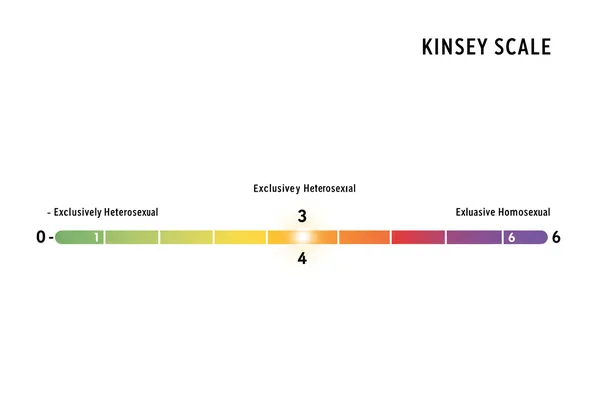金赛量表分数 3:中间位置的意义
你是否参加过 金赛量表 测试并获得了 3 分?如果是这样,你可能会看着这个数字,想知道 金赛量表上的 3 分意味着什么? 这是一个常见的求知和自我反思点。落在这一著名性取向光谱的中心位置,可能会让人觉得意义重大,甚至有点困惑。让我们探讨一下金赛 3 分的真正含义,它如何与当代身份认同联系起来,以及这种洞察力如何能助你踏上自我发现之旅。
金赛分数不仅仅是一个数字;它是你与自己进行深入对话的起点。它提供了一个新的视角来看待你的吸引力和经历。如果你准备好更好地了解自己,可以随时通过我们的私人而富有洞察力的测试 探索你的性取向。
理解金赛分数 3:核心定义
在金赛量表上获得 3 分,意味着你正好处于性取向光谱的中间点。该量表范围从 0 分(定义为完全异性恋)到 6 分(定义为完全同性恋)。因此,3 分是支点,是这两个极端之间的平衡点。理解其含义需要审视其官方定义以及该量表背后的革命性思想。
这个分数是理解 金赛量表 的重要组成部分,它代表了在阿尔弗雷德·金赛博士研究之前经常被忽视的人类体验的重要组成部分。
金赛量表上的“3”意味着什么?
在阿尔弗雷德·金赛及其同事进行的原始研究中,3 分被定义为“对异性恋和同性恋吸引力程度相当”。这意味着获得 3 分的个体对同性和异性的人群会经历大致相同的吸引力、浪漫情感或性反应。这并非指“半同性恋”或“半异性恋”,而是指一种更全面的吸引能力,不受性别限制。
这个定义涵盖了广泛的经验。对一些人来说,它可能意味着与不同性别的人有过恋爱关系史。对另一些人来说,它可能是关于幻想和吸引力,即使他们的生活经历只与一种性别的人有关。关键在于吸引力的平等潜力,这使得 金赛量表 的中间位置成为一个独特而有效的位置。

金赛的最初愿景:一个光谱,而非类别
金赛研究中最具开创性的方面之一是他拒绝了僵化的性取向二元分类。在他的研究之前,社会普遍将人视为异性恋或同性恋,中间没有空间。金赛提出,人类性取向远比这复杂和流动,它存在于一个连续体上。该量表是他展示人类吸引力这种美丽多样性的方式。在金赛研究所了解更多关于 阿尔弗雷德·金赛博士的开创性研究。
3 分是这一理念的最终体现。它表明性取向不必是一个“非此即彼”的选择。它可以是一种“既是也是”的体验。这种视角使个体能够拥抱自己情感的细微之处,而不会感到被强迫去适应预设的框架。如果你好奇自己在这个光谱中的位置,可以随时在我们的主页上 获取你的分数。
金赛 3 分与双性恋:探索其联系
对于今天许多人来说,金赛 3 分的描述——对不同性别的同等吸引力——听起来很像现代双性恋的定义。有关 双性恋及其定义 的更多阅读,请参考 GLAAD 的资源。这种联系是强烈而有效的,对许多人来说,金赛量表上的 3 分与双性恋身份的联系 提供了一种被认可和归属感。然而,分数与身份之间的关系是微妙的,探索这些细微之处非常重要。
这种联系可以成为你身份探索的强大催化剂,帮助你发现最能真实表达 你 经历的语言。
金赛 3 分总是双性恋吗?细微之处与观点
虽然 3 分与双性恋的定义密切相关,但重要的是要记住,测试分数与个人身份并非一回事。“双性恋”是一个个体选择接受的身份标签。而金赛量表则被设计为一种研究工具,用于测量特定时间点的行为和心理反应。
一些获得 3 分的人自豪地认同自己是双性恋。其他人可能更喜欢不同的标签,如泛性恋、酷儿,或者根本不选择任何标签。分数本身衡量的是吸引力的数据;而赋予其意义的人是你。将分数视为一条信息,你的身份则是你用这条信息讲述的故事。这是你关于 性取向 的个人叙述。
“居于中间”的体验
对不止一种性别抱有吸引力,可能是一种极其丰富和充实的体验。它也可能带来独特的挑战,例如来自异性恋和同性恋群体的被忽视感或误解。这种经历,有时被称为“bi-erasure(双性恋抹杀)”,是许多在量表中间位置得分的人能够感同身受的。
获得 3 分可能是一个深刻的认可时刻。它肯定了你的感受是真实的、有记录的,并被许多其他人所分享。它证实你并非异常,而是人类性取向广泛而多样化光谱的一部分。这种认可是自我接纳的基石,也是你 自我发现 之旅中的关键一步。

你的金赛 3 分之旅:超越标签
收到你的金赛量表分数并非你探索的终点;而是起点。3 分是一个强有力的邀请,鼓励你更深入地审视自己的感受,理解你的吸引模式,并拥抱性流动性。它是一个个人成长的工具,而不是对你现在是谁或将来会成为谁的最终定论。
这是你的旅程,分数只是沿途的一个路标。要开始你的冒险,你可以在我们的网站上参加 金赛量表测试。
性流动性:你的金赛分数会随时间改变吗?
一个非常常见的问题是金赛分数是否是永久不变的。答案是否定的。阿尔弗雷德·金赛本人指出,一个人在量表上的位置可能会在一生中发生变化。性取向并非总是固定不变的;对许多人来说,它是流动的,并会随着新的经历、关系和自我反思而演变。这个概念通常被称为 性流动性。
你今天可能得了 3 分,但五年或十年后,你可能会发现你的吸引力有所不同。这完全正常且有效。金赛分数是一个快照,而不是永久性的纹身。拥抱变化的可能性能让你感到解放,让你在当下真实地生活,而不必担心符合过去或未来的期望。这是 身份探索 的核心部分。

驾驭自我发现和个人成长
那么,你如何利用这些新发现的信息呢?将其作为成长的催化剂。3 分鼓励你在生活的各个领域挑战二元思维(binary thinking)。这是一个以开放的心态反思你过去的吸引力、现在的渴望和未来可能性的机会。
考虑记录你的感受或与信任的朋友或伴侣交流。探索线上和线下社区,在那里双性恋和性流动性被公开讨论。最重要的是,给自己宽容和耐心。理解你的 性取向光谱 的旅程是终生的,我们的 互动工具 将全程支持你。
你的金赛分数是一个指引,而非限制
金赛量表 3 分将你置于性取向光谱充满活力的核心——这是一个引人入胜且完全有效的结果。它表示对不同性别具有同等的吸引力,与现代双性恋的身份密切相关,但最终定义权仍掌握在你手中。这证明了人类性取向是一个多样化且流动的连续体。
请记住,这个分数不是一个僵化的标签,而是一个洞察工具和自我探索的指南。它是你独特故事的一部分。你的理解之旅是个人且深刻的,值得以安全和支持的方式进行探索。如果你准备好继续你的探索,我们邀请你今天就在我们的主页上 开始你的金赛量表探索。
关于金赛分数 3 的常见问题
金赛量表上的 3 分具体意味着什么?
金赛量表 上的 3 分代表个体在吸引力或经历上“对异性恋和同性恋吸引力程度相当”。它位于 0-6 量表的精确中点,意味着对同性和异性的人群具有平衡的吸引力潜力。
金赛量表 3 分意味着我是双性恋吗?
许多获得 3 分的人认同自己是双性恋,因为这个定义与被不止一种性别吸引的经历密切相关。然而,分数本身衡量的是吸引力,而“双性恋”是一个个人身份标签。只有你才能决定哪个标签(如果有的话)最适合你。你的分数是一个洞察工具,而非诊断。
我的金赛量表 3 分将来会改变吗?
是的,它绝对会改变。 金赛量表 背后的核心原则之一是,一个人的性感受和行为可能会在一生中发生变化。这个概念被称为性流动性。你的分数反映了你在测试时的感受,而不是你身份的永久固定特征。
我在哪里可以了解更多关于金赛量表的信息?
要了解更多并直接使用这个自我发现工具,最好的起点就在这里。你可以参加我们的全面而私密的 在线测试,以获得个人见解。我们的网站还提供丰富的资源,解释该量表的历史、方法论和重要性。